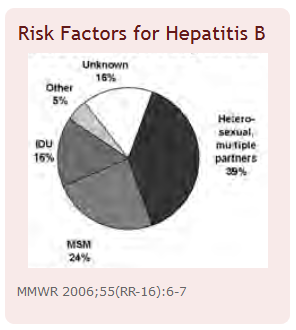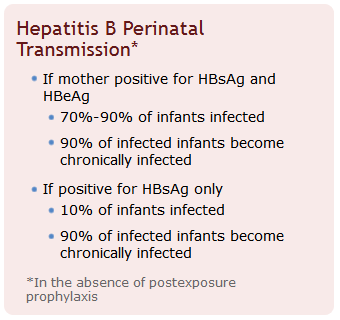Hepatitis B risk factors: Difference between revisions
| Line 12: | Line 12: | ||
* Young children in day-care or residential settings with other children in [[endemic]] areas | * Young children in day-care or residential settings with other children in [[endemic]] areas | ||
* Sexual/household contacts of [[infected]] persons | * Sexual/household contacts of [[infected]] persons | ||
* Patients and employees in [[haemodialysis]] | * Patients and employees in [[haemodialysis]] centers | ||
* Injection drug users sharing unsterile needles | * Injection drug users sharing unsterile needles | ||
* People sharing unsterile medical or dental equipment | * People sharing unsterile medical or dental equipment | ||
| Line 29: | Line 29: | ||
|} | |} | ||
==Hepatitis B Reactivation=== | |||
Hepatitis B virus presents in all patients with infection. Patients who are either HBsAg positive or anti HBc positive are at the risk of heaptitis B reactivation. | |||
Hepatits B reactivation can occurs by following m | |||
Paitents are at risk for HBV reactivation in following conditions:<ref name=> Europian Medicines Agency. reviews direct-acting antivirals for hepatitis C. (2016) http://www.ema.europa.eu/docs/en_GB/document_library/Referrals_document/Direct-acting_antivirals_for_hepatitis_C_20/Procedure_started/WC500203479.pdf </ref> | |||
*Receive immunosuppressive therapy | |||
**[[Chemotherapy agents]] | |||
**Tumor necrosis factor (TNF) inhibitor (Infliximab) | |||
**Methotrexate (particularly following its withdrawal) [42-44] | |||
**Abatacept | |||
**Ustekinumab | |||
**Anti-CD 20 agents (Rituximab and Ofatumumab) | |||
**High to moderate dose [[glucocorticoids]] | |||
*Patients treated with direct-acting antivirals for hepatitis C | |||
**Daklinza | |||
**Exviera | |||
**Harvoni | |||
**Olysio | |||
**Sovaldi | |||
**Viekirax | |||
== References == | == References == | ||
Revision as of 17:56, 5 October 2016
|
Hepatitis B |
|
Diagnosis |
|
Treatment |
|
Case Studies |
|
Hepatitis B risk factors On the Web |
|
American Roentgen Ray Society Images of Hepatitis B risk factors |
|
Risk calculators and risk factors for Hepatitis B risk factors |
Editor-In-Chief: C. Michael Gibson, M.S., M.D. [1]; Associate Editor(s)-in-Chief: João André Alves Silva, M.D. [2]
Overview
Common risk factors in the development of HBV infection includes sexual contact with infected individuals, infected household contacts, intravenous drug use, travel to endemic regions, perinatal transmission from infected mothers to infants, and occupation.
Risk Factors
Individuals who are at increased risk of hepatitis B infection include:
- Infants born to infected mothers
- Young children in day-care or residential settings with other children in endemic areas
- Sexual/household contacts of infected persons
- Patients and employees in haemodialysis centers
- Injection drug users sharing unsterile needles
- People sharing unsterile medical or dental equipment
- People providing or receiving acupuncture and/or tattooing with unsterile medical devices
- Persons living in regions or travelling to regions with endemic hepatitis B
- Sexually active heterosexuals
- Men who have sex with men
- Hemophilia patients
- Travel to areas where hepatitis B is common
Frequent and routine exposure to blood or serum is the common denominator of healthcare occupational exposure.[1]
 |
 |
Hepatitis B Reactivation=
Hepatitis B virus presents in all patients with infection. Patients who are either HBsAg positive or anti HBc positive are at the risk of heaptitis B reactivation. Hepatits B reactivation can occurs by following m Paitents are at risk for HBV reactivation in following conditions:[3]
- Receive immunosuppressive therapy
- Chemotherapy agents
- Tumor necrosis factor (TNF) inhibitor (Infliximab)
- Methotrexate (particularly following its withdrawal) [42-44]
- Abatacept
- Ustekinumab
- Anti-CD 20 agents (Rituximab and Ofatumumab)
- High to moderate dose glucocorticoids
- Patients treated with direct-acting antivirals for hepatitis C
- Daklinza
- Exviera
- Harvoni
- Olysio
- Sovaldi
- Viekirax
References
- ↑ "Hepatitis B" (PDF).
- ↑ 2.0 2.1 "Center for Disease Control and Prevention (CDC)".
- ↑ Europian Medicines Agency. reviews direct-acting antivirals for hepatitis C. (2016) http://www.ema.europa.eu/docs/en_GB/document_library/Referrals_document/Direct-acting_antivirals_for_hepatitis_C_20/Procedure_started/WC500203479.pdf